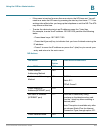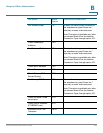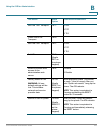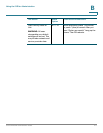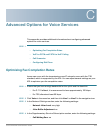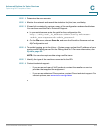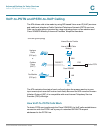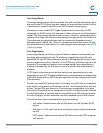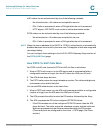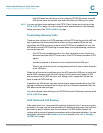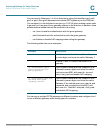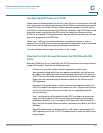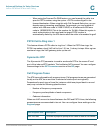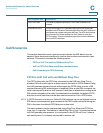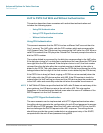
Advanced Options for Voice Services
VoIP-to-PSTN and PSTN-to-VoIP Calling
Cisco SPA232D Administration Guide 216
C
One-Stage Dialing
One-stage dialing allows a call to be started over VoIP and then immediately get a
dial tone on the PSTN. When you take a phone off hook and dial a number, the call
is automatically routed to the VoIP or the PSTN, based on the dial plan.
Optionally, you can enable HTTP Digest Authentication. In this case, the ATA
challenges the INVITE with a 401 response if it does not have a valid Authorization
header. The Authorization header should include a <
User ID
n> parameter, where n
refers to one of eight VoIP user accounts that can be configured on the ATA device.
The credentials are computed based on the corresponding password using
Message Digest 5 (MD5). The <
User ID
n> parameter must match one of the VoIP
accounts stored on the ATA device. You can configure these settings on the PSTN
(LINE Port) page.
Two-Stage Dialing
In two-stage dialing, the LINE port goes off-hook but does not automatically dial
any digits after accepting the call. To invoke two-stage dialing, the VoIP caller
should INVITE the PSTN line without the user-id in the Request-URI or with a user-
id that matches exactly the <
User ID
n> of the PSTN Line. A different user-id in the
Request-URI is treated as a request for one-stage dialing if one-stage dialing is
enabled, or dropped by the ATA (as if no user-id is given) if one-stage dialing is
disabled.
HTTP Digest Authentication can be also used for two-stage dialing, as in one-
stage dialing. If using HTTP Digest Authentication or Authentication is disabled, the
VoIP caller should hear the PSTN dial tone right after the call is answered (by a SIP
200 response).
You also can enable PIN authentication. In this case, the VoIP caller is prompted to
enter a PIN number after the ATA answers the call. The PIN number must end with
a # key. The inter-PIN-digit timeout is 10 seconds (not configurable). Up to eight
VoIP caller PIN numbers can be configured on the ATA. A dial plan can be selected
for each PIN number. If the caller enters a wrong PIN or the ATA times out waiting
for more PIN digits, the ATA tears down the call immediately with a BYE request.
The call scenarios may involve the following types of callers:
• VoIP caller—Someone who calls the ATA device via VoIP to obtain PSTN
service
• VoIP user—A VoIP caller that has a user account (user-id and password) on
the ATA
• PSTN caller—Someone who calls the ATA device from the PSTN to obtain
VoIP service



